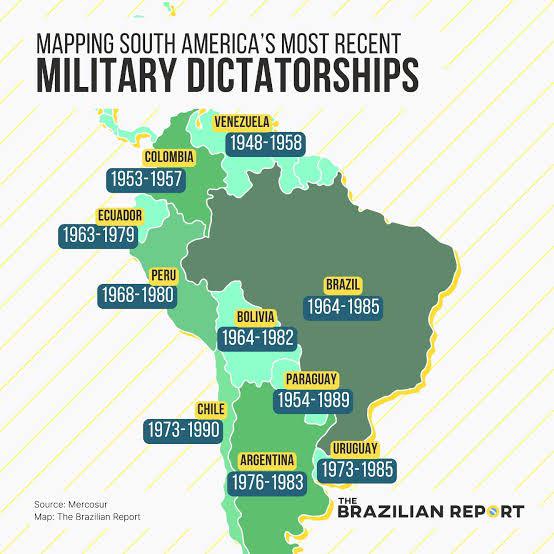South America Military Dictatorships Map


David Chen
Data Visualization Specialist
David Chen is an expert in transforming complex geographic datasets into compelling visual narratives. He combines his background in computer science ...
Geographic Analysis
What This Map Shows
The "South America Military Dictatorships Map" provides a stark visual representation of the political turmoil that gripped the continent during the latter half of the 20th century. From Brazil to Chile, Argentina to Uruguay, this map delineates the countries that experienced military coups and the subsequent dictatorships that ruled with an iron fist. It highlights a dark chapter in South American history where fear, repression, and violence were rampant.
Interestingly, many of these regimes were supported, either directly or indirectly, by the United States, which complicates the narrative of American exceptionalism often seen in the global discourse. This map serves to remind us of the human cost of political intervention and the struggles faced by entire generations who lived under oppressive regimes.
Deep Dive into Military Dictatorships in South America
The phenomenon of military dictatorships in South America primarily took root in the mid-20th century, peaking during the 1970s and 1980s. This period was characterized by numerous military coups, where governments were overthrown, and authoritarian regimes were installed. Countries such as Argentina, Chile, and Brazil became notorious for their brutal military governments, which employed tactics of state terror, including censorship, torture, and forced disappearances.
For instance, in Chile, General Augusto Pinochet led a coup in 1973, ousting President Salvador Allende. Under Pinochet’s rule, thousands of Chileans were detained, tortured, or killed. The National Commission on Political Imprisonment and Torture reported over 40,000 victims of political repression, with many still missing today. Similarly, Argentina's military junta from 1976 to 1983 is infamous for the "Dirty War," where an estimated 30,000 people were forcibly disappeared.
What’s fascinating is how the United States played a role in these events. Through initiatives like Operation Condor, the U.S. provided support to various South American regimes, viewing them as bulwarks against communism during the Cold War. This assistance often came in the form of military training, financial aid, and intelligence-sharing, which enabled these regimes to carry out their oppressive tactics with a sense of impunity.
Moreover, Brazil’s military dictatorship lasted from 1964 to 1985, during which the regime suppressed dissent and engaged in severe human rights violations, including torture and extrajudicial killings. The Brazilian government’s own documents, recently declassified, reveal the extent of the atrocities committed during this period.
Regional Analysis
Looking at the map, we can see distinct regional patterns in the prevalence and impact of military dictatorships across South America. Southern Cone countries—Argentina, Chile, Uruguay, and Paraguay—experienced some of the most intense periods of repression. The proximity of these nations often led to coordinated efforts in state terrorism, as evidenced by Operation Condor, which facilitated cross-border cooperation among dictatorships.
In contrast, countries like Colombia and Venezuela had different experiences. Although both faced significant political violence and authoritarian tendencies, they did not undergo military dictatorships to the same extent as their southern neighbors. Colombia's long-standing conflict has roots in civil strife and drug-related violence, while Venezuela's recent challenges stem from economic collapse and political turmoil, rather than a direct military takeover.
Interestingly, even nations such as Bolivia and Ecuador, which experienced military coups, had shorter periods of dictatorial rule compared to the Southern Cone. Bolivia, for example, saw a series of coups and shifts in power, yet returned to democratic governance more quickly than its neighbors.
Significance and Impact
Understanding the legacy of military dictatorships in South America is crucial for comprehending the region's contemporary political landscape. The scars of these oppressive regimes have left lasting impacts, including lingering distrust in government institutions and a population often wary of military involvement in politics.
Moreover, the historical context of U.S. intervention complicates current geopolitical narratives. As the world reflects on issues of human rights and democracy, it is essential to acknowledge the past mistakes that led to such suffering. Today, many South American countries are working towards reconciliation and justice for the victims of state violence, aiming to ensure that such dark chapters do not repeat themselves.
As we look to the future, the lessons learned from the military dictatorship era could inform current political discourse and human rights policies, both locally and globally. With ongoing discussions about democracy and governance in the region, this map serves as a powerful reminder of the complexities and challenges that continue to shape South America's path forward.
Visualization Details
- Published
- August 15, 2025
- Views
- 124
Comments
Loading comments...